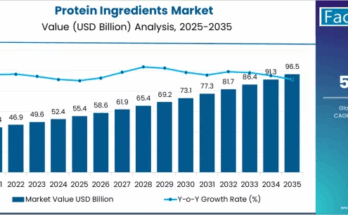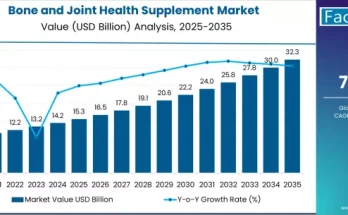The global organic emulsifiers and stabilizers market is on a robust growth path, propelled by the surge in consumer demand for clean-label, plant-based, and sustainable food ingredients. According to a recent report by Fact.MR, the market is projected to increase from USD 3.4 billion in 2025 to approximately USD 5.7 billion by 2035, recording an absolute increase of USD 2.2 billion over the forecast period. This reflects a compound annual growth rate (CAGR) of 5.3% between 2025 and 2035.
The market’s trajectory is shaped by shifting consumer preferences toward healthier formulations, increasing adoption of organic food products, and continuous innovation in natural hydrocolloids and bio-based emulsification technologies. Manufacturers are increasingly investing in R&D to replace synthetic additives with natural alternatives that offer both stability and functionality without compromising taste or texture.
Strategic Market Drivers
- Clean Label and Organic Food Revolution
Rising health awareness and consumer demand for transparency have fueled the preference for clean-label ingredients. Food processors are replacing artificial emulsifiers with plant-based and fermentation-derived solutions. Organic emulsifiers such as lecithin, acacia gum, and guar gum are witnessing rapid adoption across bakery, beverages, dairy, and plant-based food segments.
- Functional and Nutritional Benefits
Organic stabilizers and emulsifiers not only enhance texture and shelf life but also offer nutritional and functional benefits. New product formulations increasingly use organic polysaccharides, proteins, and natural lipids to provide emulsification, water-binding, and foaming properties. These functional additives support product innovation in vegan, gluten-free, and fortified foods.
- Regulatory Push Toward Natural Additives
Global food safety authorities, including the FDA and EFSA, are tightening regulations around synthetic additives and promoting natural, safe alternatives. This has encouraged manufacturers to adopt organic-certified ingredients that meet strict safety and sustainability standards—further accelerating market expansion.
- Growth in Natural Cosmetics and Personal Care
Beyond food applications, organic emulsifiers and stabilizers are gaining momentum in cosmetics, pharmaceuticals, and personal care formulations. Their natural origin, hypoallergenic properties, and environmental compatibility align with the clean beauty movement, creating a lucrative opportunity for diversification.
Regional Growth Highlights
North America: Innovation and Health-driven Expansion
North America remains a major hub for organic food and beverage innovation, driven by increasing consumer awareness and a strong regulatory framework favoring organic certification. The U.S. leads in R&D investments focused on plant-based emulsifiers derived from soy, sunflower, and oat lecithin.
Europe: The Clean Label Pioneer
Europe dominates the global organic emulsifiers and stabilizers market, driven by its mature organic food sector and stringent EU standards. Countries such as Germany, France, and the Netherlands are spearheading innovations in plant-based dairy alternatives, natural hydrocolloids, and bio-based stabilizers.
East Asia: Fastest-Growing Market
East Asia is emerging as the fastest-growing region, fueled by expanding processed food industries in China, Japan, and South Korea. Rising disposable incomes and the increasing penetration of organic-certified food and cosmetic products are boosting regional demand.
Emerging Markets: Latin America and Middle East & Africa
Emerging economies are witnessing growing consumer awareness of natural ingredients and expanding retail distribution of organic products. Government incentives for sustainable agriculture and organic farming are further supporting local ingredient manufacturing capabilities.
Market Segmentation Insights
By Source
- Plant-based emulsifiers dominate, particularly those derived from soy, sunflower, and guar.
- Microbial and fermentation-based stabilizers are gaining traction due to consistency and scalability.
By Application
- Food & Beverages: Bakery, dairy, beverages, and confectionery represent the largest demand share.
- Cosmetics & Personal Care: Rising use of organic surfactants and emulsifiers in creams, lotions, and shampoos.
- Pharmaceuticals: Increasing incorporation in drug formulations for solubilization and stabilization.
By Function
- Emulsification
- Stabilization
- Texturization
- Preservation
Challenges and Market Considerations
While growth prospects remain strong, the industry faces several key challenges:
- High Production Costs: Organic raw materials and certification processes increase input costs.
- Supply Chain Limitations: Seasonal variations and raw material scarcity impact consistent supply.
- Shelf-life Limitations: Natural emulsifiers may offer shorter shelf life compared to synthetic counterparts.
- Regulatory Complexity: Global certification standards vary, requiring region-specific compliance strategies.
Competitive Landscape
The global organic emulsifiers and stabilizers market is highly competitive, with a mix of established multinational companies and emerging natural ingredient specialists. Key players are focusing on expanding their product portfolios, enhancing sourcing sustainability, and investing in research for next-generation bio-based emulsification technologies.
Key Players in the Organic Emulsifiers and Stabilizers Market:
- CP Kelco
- Cargill
- DuPont
- Ingredion
- Ashland
- Tate & Lyle
- Archer Daniels Midland (ADM)
- Kerry Group
- GreenTech Processing
- Sustainable Ingredients Group
These players are forming partnerships with food and cosmetic brands to co-develop organic-certified formulations, leveraging consumer demand for traceable, environmentally responsible ingredients.
Sustainable Ingredients Group’s Strategic Positioning
Sustainable Ingredients Group (SIG) is well-positioned to capitalize on the growing market by focusing on:
- R&D in Natural Formulations: Developing high-performance organic emulsifiers tailored for food, cosmetic, and nutraceutical applications.
- Sustainable Sourcing: Establishing supply chains rooted in regenerative agriculture and fair-trade practices.
- Geographical Expansion: Targeting high-growth regions such as East Asia and North America through strategic alliances.
- Collaborations with Brands: Partnering with leading clean-label product manufacturers to co-create eco-certified solutions.
Future Outlook: Toward a Healthier, Sustainable Ingredient Ecosystem
The next decade will mark a major transformation in the global emulsifiers and stabilizers landscape. As the food, cosmetic, and pharmaceutical industries converge around clean-label, sustainability, and functionality, organic solutions will become the new standard.
Companies that align innovation with transparency and ethical sourcing will lead this evolution. With its focus on natural innovation, responsible sourcing, and global collaboration, Sustainable Ingredients Group is poised to drive the future of organic emulsification and stabilization—paving the way for a healthier, cleaner, and more sustainable world.



